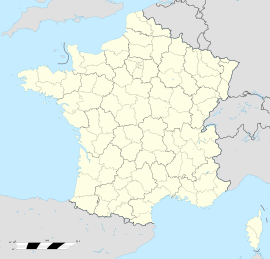- Châteauneuf-Miravail
-
Châteauneuf-Miravail

Administration Country France Region Provence-Alpes-Côte d'Azur Department Alpes-de-Haute-Provence Arrondissement Forcalquier Canton Noyers-sur-Jabron Intercommunality Vallée du Jabron Mayor Jean-Claude Chabaud
(2008–2014)Statistics Elevation 619–1,628 m (2,031–5,341 ft)
(avg. 710 m/2,330 ft)Land area1 19.7 km2 (7.6 sq mi) Population2 75 (2008) - Density 4 /km2 (10 /sq mi) INSEE/Postal code 04051/ 04200 1 French Land Register data, which excludes lakes, ponds, glaciers > 1 km² (0.386 sq mi or 247 acres) and river estuaries. 2 Population without double counting: residents of multiple communes (e.g., students and military personnel) only counted once. Coordinates: 44°09′47″N 5°43′38″E / 44.1630555556°N 5.72722222222°E
Châteauneuf-Miravail is a commune in the Alpes-de-Haute-Provence department in southeastern France.
Inhabitants are known as Castelnovins.
Contents
Geography
The Jabron and Druigne rivers run through it.
History
An altar to the Roman god Mars dates back to the Gallo-Roman era.
Charters for the locality first appeared in the twelfth century, when the town acted as a stronghold for the town of Saint-Vincent-sur-Jabron.
During the revolution, a Patriotic Society was formed in the town, created in 1792. Following the decree of the National Convention of October 16, 1793 for towns holding names reminiscent of royalty or feudalism to create new names, the community became known as Auche-la-Garde.
Population
Historical population of Châteauneuf-Miravail 1765 1793 1800 1806 1821 1831 1836 1841 1846 1851 512 558 568 612 625 626 494 560 600 511 1856 1861 1866 1872 1876 1881 1886 1891 1896 1901 440 385 386 348 362 332 330 320 278 277 1906 1911 1921 1926 1931 1936 1946 1954 1962 1968 242 232 191 163 139 133 118 82 58 54 1975 1982 1990 1999 2008 62 71 57 68 75 Sights
The Jabron valley is dominated by the ruins of the seventeenth century Chateau Graves. On the Aouche la Garde ridge stand a tower and curtain wall, now in ruins, which survey the Jabron and Chateauneuf valleys,
In Lange, the principal section of the commune, one home is inscribed with the date 1620 on its lintel.
The church of Saint Mari (also Saint Mary) in Lange is considered exceptional by French historian Raymond Collier, who gives the building considerable attention in his book La Haute-Provence monumentale et artistique. The nave and apse of the church are barrel vaulted. The apse is rectangular in shape with a flat chevet. The posterior walls of each aisle are of original seventeenth century construction, a rarity for the region. The current facade is in fact modified from the original: while the wall and bell tower are on the same axis, it is a different axis from that of the nave. The choir and the nave are of typical construction for the late thirteenth and early fourteenth century period in which they were built.
The church holds a statue of Saint Mary. The image of the crucifixion contained within the church shows Christ on the cross, with the Virgin and two unidentified people to his left. The image is unusual in that it is surrounded by two penitent figures. A painting of Saint Roch as a pilgrim with his dog with the patron saint of the church can also be seen. This painting is rare in that Saint Roch is typically depicted in sculpture rather than pictorial image.
Another painting, dating to 1687 although painted in a post-primitive style, represents Saint Joseph holding a scepter and book. On each of his sides stand Saint Patrick and Saint Eloi. The painting is considered a historic monument.
See also
References
Categories:- Communes of Alpes-de-Haute-Provence
- Alpes-de-Haute-Provence geography stubs
Wikimedia Foundation. 2010.

